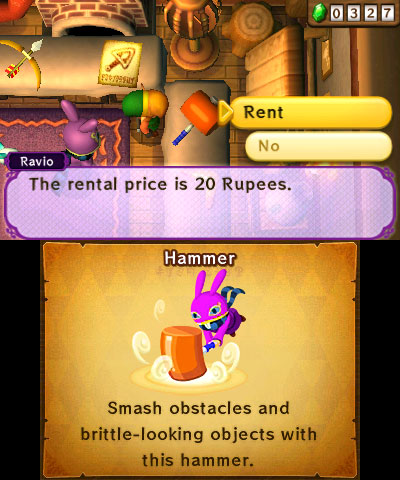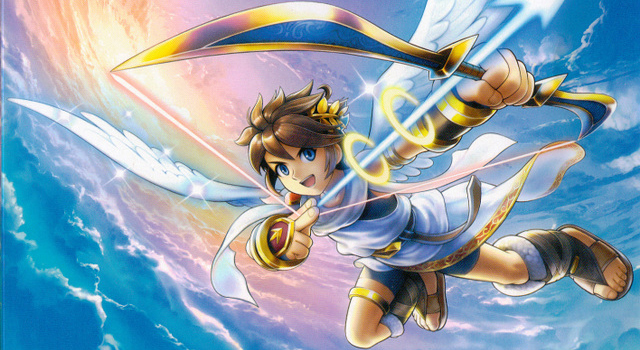The Legend of Zelda: A Link Between Worlds — Searching Hy and Lo

Being skeptical of The Legend of Zelda: A Link Between Worlds’ potential quality was far too easy. A development team within Nintendo was brave (or foolish) enough to work on a sequel to SNES classic The Legend of Zelda: A Link to the Past, one of the best games released on the Super Nintendo, and one of the best released during its era in 1991. We’re in a time where the company has come under fire for recent Zelda games sticking too close to a formula established decades ago. It was ostensibly impossible for a new Zelda game to feel fresh, and making this a sequel to one released over two decades ago was a good way to make it come off as even less fresh.
The media Nintendo disseminated in the interim between its announcement and release didn’t help either. The game took place in the same world as its predecessor, and thus uses the same world map and similar concepts. ALBW wasn’t as easy on the eyes either, opting for low-quality 3D polygons on a 2D plane rather than pretty 2D sprites, putting it right on par with the much-maligned (in geek circles, at least) New Super Mario Bros. titles. The character models lack detail and polish, even for the main characters; the close-up shots during cutscenes aren’t pretty. The odds were stacked against it, to the point where I could imagine the development team regretting their decision while it was too late to change course.
(Funnily enough, according to the game’s Iwata Asks installment, they considered calling it “New Legend of Zelda” at one point. That would have increased the already high amount of skepticism tenfold.)
I’m glad they didn’t change their course, because ALBW is not only a game that lives up to its predecessor, but somehow ended up being the best Zelda game released in years.

A familiar sight for any Zelda fan.
The game is no looker, sure, but thoughts about its visual style will slowly evaporate as you spend more time controlling it. The team put playability over looks, making actions like walking diagonally and attack in multiple directions far easier and smoother. The controls in the older 2D games weren’t bad, but this game’s scheme makes them feel downright limited. Add in the ability to quickly select items you need to use and assign them to the requisite buttons, and it makes for a polished experience.
That’s far from the biggest evolution the franchise received with this installment. Gone is the need to acquire every item in dungeons in an almost-linear order, an issue became more burdensome and tired in recent installments. Instead, you’ll start out by renting them for Rupees from an ostensibly friendly creature named Ravio, who you’ll meet before the first dungeon. You’ll need to get specific items from him before venturing into certain dungeons, which is indicated on blocks next to the entrance of each one. It shows that the items will be needed to complete those dungeons. Eventually, Ravio will give you the option of buying them, and thankfully the game is so generous with Rupees that this isn’t a pain.

Now you always have something to use those Rupees for!
On the surface, it sounds annoying to head towards a dungeon location and find out you don’t have the piece of equipment needed to progress, then head back to Ravio’s place to grab it and retrace your steps. That’s not a problem, because of how quickly Link treks across the game’s world. When I mentioned how much of a breeze the game was to control, I was also referring to the rapid pace Link travels at, too — the benefit of the game being 2D.
Actually, that should be “worlds.” As the title implies, Link moves between two worlds throughout the game: Hyrule and Lorule. Though Nintendo reused the light and dark world concepts from LttP, it’s what they did with them that matters. Link also has the ability to flatten himself and move through walls, which adds a new dynamic to exploration. It sounds gimmicky, but it’s utilized in a way that makes it feel like a necessary addition.

This looks familiar! But it isn’t.
It’s nice that ALBW is designed so most of its dungeons can be completed in any order, making the game an open world title. That sadly came at a cost of its difficulty. It’s easily the least challenging 2D Zelda title Nintendo has made, and it comes off as feeling like the developers didn’t feel like balancing it around the player’s evolving skills. The dungeons and enemies in Lorule are considerably more difficult than Hyrule’s, but it’s still blow other games in the series. The puzzles fare a little better, but still end up being some of the easiest to grace a Zelda game. While the developers added some features to change up the formula, it will be better if they can implement this with a nice sense of challenge in the future.
There’s more of a story between the two worlds concept in ALBW than there was in LttP, though it’s not as heavy-handed and is far less consequential than any of the 3D Zelda games — or even some of the later 2D iterations. It’s, for all intents and purposes, a throwback to Zelda games of old. The most I can say without spoiling anything is that the trek between both worlds involves Link tracking a mysterious figure named Yuga, whose nefarious plans could jeopardize the future of Hyrule. It sounds rudimentary on the surface, but it has some clever twists down the line. Just don’t go in expecting rich towns brimming with verisimilitude and world-building like the recent games. Anyone looking for that will have to wait for the Wii U Zelda; after Hyrule Warriors.

Link, seen here going between worlds.
Despite the obvious homage to games of old though, the story ends up feeling barely there most of the time. I appreciate that Nintendo is listening to the criticism older games received, but it’s as if they took the criticism Skyward Sword received too much to heart. It’s eerily reminiscent of what happened to the Paper Mario franchise between Super Paper Mario and Paper Mario: Sticker Star, albeit to a much lesser extent. It thankfully doesn’t do much harm to ALBW at its core.
Like any Zelda game worth its salt, ALBW is packed full of secrets, many of which make clever use of a new wall-flattening gimmick. Though all of the bosses have patterns, and are, once again, some of the easiest to make their way into a Zelda game, figuring those patterns out and exploiting their weaknesses makes them enjoyable. You’re told how many times you perished in battle at the end, so don’t be surprised if that number is “0” if you’ve played a number of Zelda games in the past.
The difficulty doesn’t hamper the joy of exploring both worlds and the game’s plethora of mini-games — many of which, like previous Zelda games, will reward you with a Piece of Heart. The baseball game aside, most of them are fun and challenging-but-fair. Plenty of heart pieces exist outside of mini-games and are cleverly hidden, once again demanding use of Link’s wall flattening technique. There’s also a special task where you have to find child Maimai’s for Mother Maiamai. For every 10 you find, Mother Maiamai will upgrade one piece of equipment you own. There’s plenty of content to keep you busy for hours, though it’s not as long and (thankfully) as stretched out as the last couple of console interations. Don’t be surprised if you find yourself dropping everything to explore the entirety of both worlds after you’ve completed a few dungeons in Lorule.

The Legend of Hilda?
ALBW soundtrack is initially deceptive, though the end results are fantastic. It cleverly tries to make you think most of the best tracks are remixes of popular themes from LttP early on. They’re fantastic, but that’s disappointing for a game that wants to break away from its predecessor a little further. It’s later on when original tracks debut, and they’re some of the best I’ve heard in a Zelda game. Nintendo’s been hammering it out of the park with their soundtracks as of late, and ALBW’s represents that trope at its best. It contains some of the best music I’ve heard in a game in the last year.
In fact, that early deceptiveness can be applied to the entirety of the game, and the music changes along with that. It takes a little time, but A Link Between Worlds is not an unnecessary sequel relying on the original’s popularity, although that’s part of the equation. It becomes its own game after unbinding itself from the figurative shackles of A Link to the Past, whose loosening begins 1/4 of the way through the quest. It’s not flawless, but the changes made to the formula while presenting the traditional Zelda experience make it one of the best installments in the franchise in years. It justifies the existence of future 2D games, and hopefully Nintendo will continue making them while refining its ideas, without falling into a predictable pattern.




To you and all who play this game: You have NOT heard the music until you have plugged the 3DS into some real speakers.
The difference in quality will blow you away. At full quality, this is some of the best music I’ve heard, ever!
You might say this soundtrack is recommended.
Yeah, seriously. That, or play the game while wearing a good pair of headphones.
I wish Nintendo released soundtracks for their games more often.